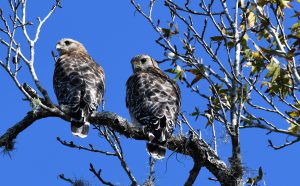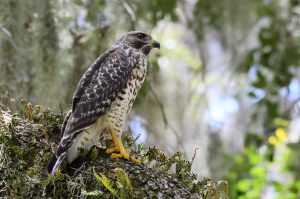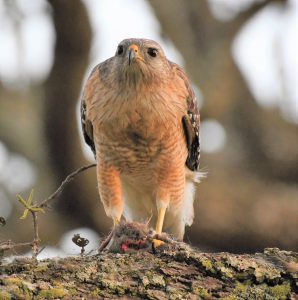Common Name: Red-shouldered Hawk
Status: Native Species
Scientific Name: Buteo lineatus – Florida subspecies is Buteo lineatus extimus
Occurrence: Year-round Species

Identification: A fairly decent sized raptor, slightly smaller than the Red-tailed hawk. Average length is about 24″ and they may have a wingspan spreading up to 43″. Both male and females are similar in appearance. The only differentiating factor is that the females are somewhat larger than the males in length and weight. Female average a whopping 700grams or 1.54lbs., while the males weigh in a trim 550grams, or 1.21lbs. The only way to truly tell them apart is if you see them side-by-side.

The wings and tailfeathers have symmetrical bands of white and black. They get their name red-shouldered, because of the reddish feathers on the shoulder. Florida red-shouldered subspecies (Buteo lineatus extimus) differ from their northern cousins regarding the color of the head and breast. The head is much paler and almost gray looking and their breast feathers are also paler in color compared to other red-shouldered hawks. The young look slightly different that the adults. They lack the strong black and whiter wing and tail feathers and do not have the red breast of the adults. Their breast is more white with short darks streaks. They are often mistaken for other raptors such as red-tailed hawks or broad-winged hawks.


Description: Red-shouldered hawks start breeding through January to May. Start looking for nest building during that time. You may see the male and female go back and forth carrying limbs and vegetation to build their nest or to touch up their seasonal nesting site. Hardwoods are the plants of choice, selecting nesting sites trees such as oaks, or cypress. Once mated and nest building or nest restoration is complete, the female lays between 3 to 4 eggs. Both parents participate in raising young. In my experience usually 1 or 2 young reach adulthood. Eggs do not hatch the same time, so there is competition from the start. When they grow older, young leave the nest in about 5 to 7 weeks but will still be dependent on parents for another 8 to 10 weeks. It takes about two years for males and females to start breeding, though some females will start breeding their first year.
Diet: Red-shouldered hawks are generalist predators. They are not picky about what they eat. they will perch on a limb or roof and dive don to capture prey, killing it very quickly. Common prey include small mammals such as rats, mice, and squirrels. One would think with as many squirrels there are, these hawks should have no problem. However, squirrels are a decent sized rodent that will fight back and the risk of injury is a threat. These hawks will actively feed on snakes, especially the diurnal black racer. Small birds are on the menu, and the occasional frog. An observation I have seen is that adults commonly feed on the invasive brown anole and juvenile hawks have been observed eating earthworms that come out early in the morning. Like most predators, they devour their prey head first.

Interesting Facts:
- Red-shouldered hawks and their active nests are protected under the federal Migratory Bird Treaty Act and under Florida law.
- Red-shouldered hawks will sometimes form an alliance with their enemy the crow to chase out great-horned owls of the area.
- Red-shouldered hawks belong to a group of birds called buteos, which contain hawks and buzzards.
- Red-shouldered hawks are an easy raptor to identify based on their call, which resemble the sound Kee-aah.
- It is estimated that 22% of adults may die each year and up tp 50% of juveniles will perish within their first year of life.
- The red-shouldered hawk is listed as a threatened species in the states of Wisconsin and Michigan, and endangered in Illinois.
Cover Photo and Other Photo Credit: Jim E. Davis
Pictures may not be used unless receive written permission from Jim E. Davis.

Pictures must be used for educational purposes only.
References: https://www.allaboutbirds.org/guide/Red-shouldered_Hawk/overview
https://myfwc.com/wildlifehabitats/profiles/birds/raptors-and-vultures/red-shouldered-hawk/
https://www.audubon.org/field-guide/bird/red-shouldered-hawk
http://www.biokids.umich.edu/critters/Buteo_lineatus/
https://txtbba.tamu.edu/species-accounts/red-shouldered-hawk/
https://www.fs.usda.gov/Internet/FSE_DOCUMENTS/fsm91_054312.pdf
 0
0
